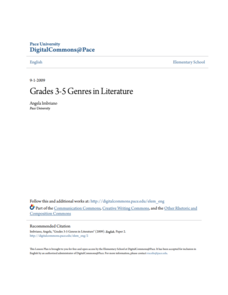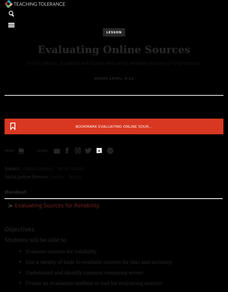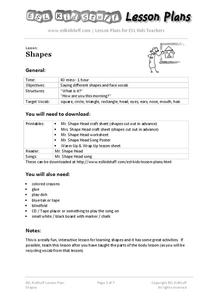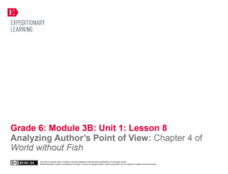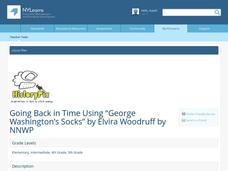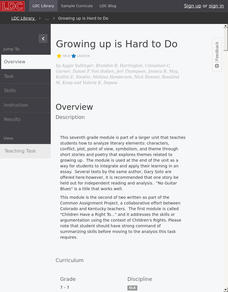EngageNY
Grade 10 ELA Module 3: Unit 1, Lesson 2
Is writing a craft? Scholars work in pairs and groups to uncover the author's craft presented in The Immortal Life of Henrietta Lacks. They answer guided questions, discuss with peers, and analyze the series of events. Completing a...
EngageNY
Grade 10 ELA Module 3: Unit 2, Lesson 13
Is that your final answer? As part of the last lesson, scholars finalize their research portfolios. They review all of their claim tools and gain the perspective of others as they discuss their work with a group. To finish, they write...
EngageNY
Grade 10 ELA Module 4: Unit 2, Lesson 2
What is the best way to determine the theme of a text? Pupils analyze how central ideas emerge in Shakespeare's tragedy Macbeth. They work in small groups and engage in a whole-class discussion to discuss the play's plot. Finally,...
EngageNY
Grade 10 ELA Module 4, Unit 2, Lesson 22
The Witches, Lady Macbeth, or Macbeth himself: who is the culprit? Using the resource, pupils craft multi-paragraph essays to present arguments about which character is responsible for the tragedy in Shakespeare's Macbeth. Additionally,...
EngageNY
Grade 10 ELA Module 4: Unit 2, Lesson 9
How does Shakespeare develop the central idea of agency versus fate in Macbeth? Using the resource, pupils work in small groups to discuss the plot of Act 3.1. Next, they complete a brief writing assignment to analyze how the main idea...
EngageNY
Grade 11 ELA Module 1: Unit 1, Lesson 3
What do words say about a person? Scholars closely examine the words Robert Browning uses to describe the Duchess in My Last Duchess. They work in groups to answer guided questions about how words help develop the Duchess as a character....
EngageNY
Analyzing Character and Theme: Tracking Control in A Midsummer Night’s Dream
Scholars examine how characters try to control one another in Shakespeare's A Midsummer Night's Dream. They engage in a read-aloud and class discussion to iron out ideas. They also work in small groups to complete a note-catcher...
EngageNY
Readers Theater: Writing a Conclusion
That's all, folks! Scholars work with their group members to create conclusions for their To Kill A Mockingbird reader's theater scripts. They use a criteria list to help guide their conclusion writing and discuss how the conclusions...
EngageNY
Building Background Knowledge: The Desegregation of Schools and Brown v. Board of Education
Scholars gain interest in the case of Brown v. Board of Education by watching a video clip and completing a quick write. They then independently read excerpts from Brown v. Board of Education and work through a Steps for Getting the Gist...
EngageNY
Determining Cascading Consequences Using The Omnivore’s Dilemma: Hunter-Gatherer Food Chain
Focusing on the consequences of the hunter-gatherer food chain that Michael Pollan discusses in The Omnivore's Dilemma, teams work together to create hunter-gatherer food chain consequences charts. Next, scholars view other groups'...
EngageNY
Evaluating an Argument: The Polyface Local Sustainable
Who has the better argument? Class members work in small groups to compare the arguments on the Example of Strong and Flawed Arguments sheet. They then analyze Michael Pollan’s argument on pages 161–166 of The Omnivore’s Dilemma and...
Curated OER
Making Your Sentences Work: Subject-Verb Agreement
Review subject-verb agreement with your class. Demonstrate the different verb forms when the subject is singular, plural, compound, and an indefinite pronoun. Not too long, this presentation is nonetheless thorough, especially for...
Pace University
Genres in Literature
Enthusiastic readers take part in a book club unit that focuses on genre, particularly historical fiction, fantasy, and adventure. Over the course of 10 days, groups read a variety of stories and choose leveled activities from a learning...
EngageNY
Discussing and Identifying Themes: What Makes a Good Children’s Book?
Working in small groups, scholars look closely at a children's book to evaluate narrative techniques. Next, they complete a Children's Book Scavenger Hunt worksheet to analyze the literary elements of their selected stories.
Teaching Tolerance
Evaluating Online Sources
Newspapers, television, social media ... how do people get their news? Using the informative resource, scholars locate and verify credible sources of information. Working in small groups, they discuss strategies for evaluating the...
ESL Kid Stuff
Intro ESL Lesson (Ages 3-7)
If you are working on colors, printing names, introductions, and other projects in the first few weeks of school, use a series of activities designed for English language learners. It includes cute ways to wish your little ones...
ESL Kid Stuff
Shapes
Work on shapes and body parts at the same time with a fun set of activities. Kids sing and read about Mr. Shape Head, who has shapes on his face, before making their own Mr. Shape Head.
School Journalism
Investigative and Data Journalism – Day One
A free press, free to investigate and report on responsibly, compelling stories, is essential to a democracy. A 10-slide presentation details where to get ideas, how to go about an investigation, gather data, and assure the accuracy of...
EngageNY
Analyzing Author’s Point of View: Chapter 4 of World without Fish
Give me a clue. Scholars work in triads to use highlighters and mark clues that lead to the author's point of view in World without Fish. The Author’s Point of View graphic organizer helps them map out their thoughts.
Institute for Humane Education
Selling "Boy" and "Girl"
Monster trucks, action figures, and video games. Are these toys designed for boys or girls? Scholars work in small groups to find and categorize examples of boy and girl toys from catalogs. Next, learners analyze the two sets of pictures...
State University of New York
Going Back in Time Using “George Washington’s Socks”
After reading Elvira Woodruff's George Washington's Socks, young readers and writers embark upon writing their own historically based story, with a focus on developing ideas and details throughout the piece. In small groups, class...
Prestwick House
The Poetry of Bob Dylan
Bob Dylan's selection as the 2016 winner of the Nobel Prize for Literature, the first songwriter ever to receive the honor, has focused the attention of a new generation on the work of the legendary artist. Class members...
Literacy Design Collaborative
Growing up Is Hard to Do
Looking for a fountain of youth? Scholars analyze a group of texts by Gary Soto that pertain to the difficulties of growing up. Activities pertaining to vocabulary, close reading, and shared writing prepare learners for the final task of...
EngageNY
Mid-Unit 2 Assessment: Comparing Fictional and Historical Texts
Class members pair up to discuss how the author of A Long Walk to Water altered history. They then work independently on Mid-Unit 2 Assessment: Comparing Water for Sudan and A Long Walk to Water. Readers close the lesson plan...














